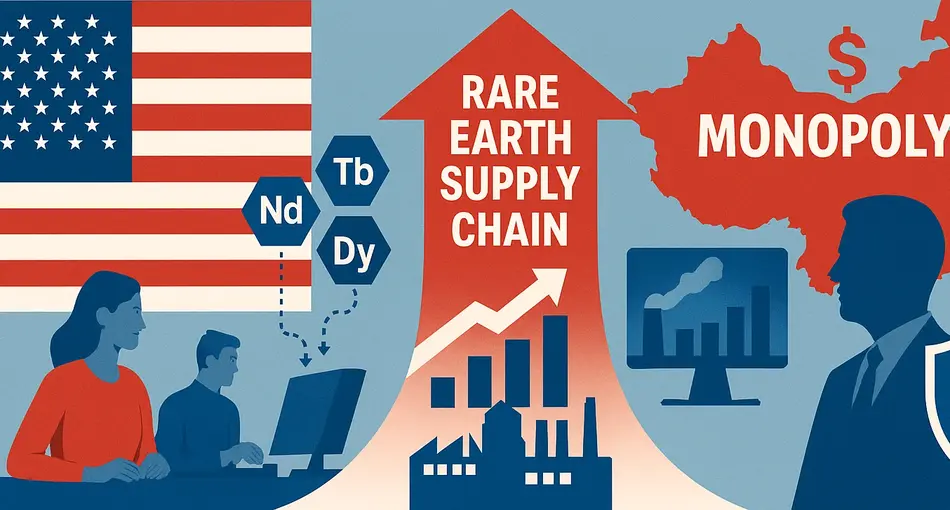Introduction: The Battle for Rare Earth Independence
The United States is engaged in a critical battle for US rare earth supply chain independence—a strategic initiative that will determine America’s technological future and economic security. As the world’s demand for rare earth elements skyrockets, driven by electric vehicles, renewable energy, and advanced technology, the United States is finally taking decisive action to break China’s decades-long monopoly on these critical materials.
At the White Mesa mill in Utah, companies like Energy Fuels are processing rare earth elements that power everything from electric vehicles and wind turbines to defense equipment and data centers. This represents more than just industrial activity—it’s a fundamental shift in America’s approach to securing the materials that drive our modern economy.
Understanding the Critical Importance of Rare Earth Elements
What Are Rare Earth Elements?
Rare earth elements refer to 17 elements on the periodic table whose atomic structure gives them special magnetic properties. Despite their name, these elements are actually abundant in Earth’s crust, but they’re often found co-mingled with other elements rather than in large, easily extractable deposits.
The most critical rare earth elements include:
- Neodymium and Praseodymium (NdPr): Essential for powerful permanent magnets
- Dysprosium and Terbium: Used in high-temperature applications
- Samarium: Critical for specialized magnetic applications
- Lanthanum and Cerium: Used in catalysts and polishing compounds
Why Rare Earths Are Essential to Modern Technology
The US rare earth supply chain independence is crucial because these materials power:
- Electric Vehicles: Permanent magnets in motors and batteries
- Wind Turbines: Generators and control systems
- Defense Equipment: Guidance systems, radar, and communications
- Consumer Electronics: Smartphones, laptops, and tablets
- Data Centers: Servers and storage systems
- Robotics and AI: Motors and sensors
China’s Dominance and the US Dependency Crisis
The Current State of Global Rare Earth Production
China currently controls approximately:
- 70% of global rare earth mining
- 90% of rare earth processing
- 80% of rare earth magnet production
This dominance gives China unprecedented leverage in the global technology supply chain and has become a critical national security concern for the United States.
How China Built Its Rare Earth Monopoly
China’s dominance in the rare earth supply chain was built through:
- Lower Labor Costs: Significantly cheaper production costs
- Weaker Environmental Standards: Less stringent regulations
- Strong Government Support: Massive state investment and subsidies
- Strategic Market Control: Pricing strategies that discouraged competition
- Integrated Supply Chain: Complete control from mining to finished products
The Environmental Cost of China’s Rare Earth Production
China’s rare earth production has come with significant environmental consequences:
- Heavy Chemical Use: Harsh chemicals used in extraction processes
- Water Pollution: Contamination of groundwater and surface water
- Air Pollution: Dust clouds from hard rock mining operations
- Vegetation Destruction: Environmental damage from mining activities
- Radioactive Waste: Improper handling of radioactive byproducts
The US Response: Building Domestic Rare Earth Independence
Strategic Investments in Domestic Production
The United States is making unprecedented investments in US rare earth supply chain independence:
- Department of Defense Investment: $400 million in MP Materials (source)
- Private Sector Funding: $1 billion loan from Goldman Sachs and JPMorgan
- Price Support Mechanisms: $110 per kilogram price floor for NdPr
- Offtake Agreements: Guaranteed purchase contracts for domestic production
Key Players in America’s Rare Earth Renaissance
Several companies are leading the charge for US rare earth supply chain independence:
MP Materials (Mountain Pass, California)
- Only operational rare earth mine in the United States
- Expanding production from 1,000 to 10,000 metric tons by 2028
- Building second magnet-making facility called “10X”
Energy Fuels (White Mesa, Utah)
- Processing rare earths from monazite feedstock
- Current capacity: 1,000 tons of NdPr annually
- Phase 2 expansion: 6,000 tons capacity
- Producing heavy rare earths: dysprosium, terbium, and samarium
Other Emerging Players
- Ramco Resources: Extracting rare earths from Wyoming coal mines
- Vulcan Elements: Making rare earth magnets for military applications
- Noveon Magnetics: Supplying magnets to Japanese motor company Nidec
The Economic Impact of Rare Earth Independence
Job Creation and Economic Growth
The US rare earth supply chain independence will create thousands of new jobs across multiple sectors:
- Mining Jobs: Extraction and processing of rare earth ores
- Manufacturing Jobs: Production of rare earth magnets and components
- Engineering Jobs: Development of new extraction and processing technologies
- Support Jobs: Logistics, transportation, and maintenance services
- Research Jobs: Development of new applications and technologies
Ready to Join the Rare Earth Revolution?
From mining and manufacturing to research and engineering, America’s rare earth resurgence is unlocking thousands of career opportunities. Explore jobs shaping the future of U.S. energy, defense, and technology.
Browse Rare Earth Jobs on WhatJobs →Investment Opportunities
The rare earth sector offers significant investment potential:
- Mining Companies: Direct investment in rare earth extraction
- Processing Companies: Investment in separation and refining facilities
- Manufacturing Companies: Production of finished rare earth products
- Technology Companies: Development of rare earth applications
- Recycling Companies: Recovery of rare earths from end-of-life products
Challenges and Obstacles to Independence
Technical Challenges
Building US rare earth supply chain independence faces several technical hurdles:
- Complex Processing: Rare earth separation requires specialized equipment and expertise
- Environmental Regulations: Stricter US environmental standards increase costs
- Workforce Development: Need for skilled metallurgical and chemical engineers
- Technology Transfer: Rebuilding lost technical knowledge and capabilities
Economic Challenges
The economics of rare earth production present significant challenges:
- High Capital Costs: Mining and processing facilities require massive investment
- Market Volatility: Rare earth prices can fluctuate dramatically
- Competition with China: Chinese producers can undercut prices through subsidies
- Supply Chain Complexity: Need to rebuild entire supply chain from scratch
Environmental and Regulatory Challenges
Environmental considerations are critical for US rare earth supply chain independence:
- Radioactive Waste: Many rare earth ores contain radioactive elements
- Chemical Processing: Use of harsh chemicals in separation processes
- Water Management: Proper handling of process water and waste streams
- Land Reclamation: Restoring mined areas to environmental standards
Innovative Solutions and Alternative Approaches
Recycling and Recovery
Recycling represents a key component of US rare earth supply chain independence:
- Apple’s Investment: $500 million investment in MP Materials for recycled magnets
- End-of-Life Recovery: Extracting rare earths from discarded electronics
- Industrial Byproducts: Processing rare earths from mining waste streams
- Urban Mining: Recovering rare earths from urban waste streams
Alternative Mining Methods
New approaches to rare earth extraction are being developed:
- Deep Sea Mining: Extracting rare earths from ocean floor deposits
- Biomining: Using microorganisms to extract rare earths
- Ion Exchange: More environmentally friendly separation methods
- Green Chemistry: Developing less toxic processing chemicals
Strategic Partnerships
International cooperation supports US rare earth supply chain independence:
- Allied Nations: Working with Australia, Canada, and other friendly nations
- Technology Sharing: Collaborating on new extraction and processing methods
- Supply Chain Diversification: Reducing dependence on any single source
- Joint Research: Developing new rare earth applications and technologies
The Path Forward: Timeline and Milestones
Short-term Goals (2024-2026)
Immediate priorities for US rare earth supply chain independence:
- Expand Existing Operations: Increase production at Mountain Pass and White Mesa
- Build Processing Capacity: Construct new separation and refining facilities
- Develop Workforce: Train workers in rare earth processing technologies
- Establish Standards: Create industry standards and best practices
Medium-term Goals (2027-2030)
Intermediate objectives for achieving independence:
- Achieve 50% Independence: Produce 50% of US rare earth needs domestically
- Build Complete Supply Chain: From mining to finished magnets
- Develop New Technologies: Improve extraction and processing efficiency
- Establish International Partnerships: Work with allied nations
Long-term Goals (2031-2035)
Long-term vision for US rare earth supply chain independence:
- Full Independence: Meet 100% of US rare earth needs domestically
- Global Leadership: Become a major exporter of rare earth products
- Technology Innovation: Lead in rare earth applications and technologies
- Environmental Leadership: Set global standards for sustainable rare earth production
What This Means for Job Seekers and Investors
Career Opportunities in Rare Earths
The US rare earth supply chain independence creates opportunities for:
- Geologists and Mining Engineers: Exploration and extraction
- Chemical Engineers: Processing and separation technologies
- Materials Scientists: Development of new applications
- Environmental Engineers: Sustainable production methods
- Business Professionals: Supply chain management and logistics
Investment Strategies
Investors can participate in US rare earth supply chain independence through:
- Direct Investment: Investing in rare earth mining and processing companies
- ETF Investment: Rare earth and critical minerals exchange-traded funds
- Technology Investment: Companies developing rare earth applications
- Infrastructure Investment: Supporting rare earth supply chain development
The Global Implications of US Rare Earth Independence
Impact on US-China Relations
US rare earth supply chain independence will significantly impact US-China relations:
- Reduced Dependence: Less vulnerability to Chinese export controls
- Increased Leverage: Better position in trade negotiations
- Technology Competition: Enhanced ability to compete in high-tech industries
- National Security: Reduced risk of supply chain disruptions
Global Supply Chain Realignment
The push for independence is reshaping global supply chains:
- Diversification: Countries seeking multiple rare earth sources
- Regionalization: Development of regional rare earth supply chains
- Technology Transfer: Sharing of rare earth processing technologies
- Environmental Standards: Global adoption of sustainable production methods
Frequently Asked Questions (FAQ)
Q: What is the current status of US rare earth supply chain independence?
A: The US rare earth supply chain independence is in early stages, with significant investments being made in domestic production. Currently, the US produces less than 10% of its rare earth needs domestically, but major investments by the Department of Defense and private sector are accelerating development.
Q: How long will it take to achieve full US rare earth supply chain independence?
A: Achieving full US rare earth supply chain independence will likely take 10-15 years. While some production capacity is coming online in the next 3-5 years, building a complete supply chain from mining to finished magnets requires significant time and investment.
Q: What are the main challenges to US rare earth supply chain independence?
A: The main challenges include high capital costs, complex processing requirements, environmental regulations, workforce development needs, and competition from China’s established supply chain with lower production costs and government subsidies.
Q: How will US rare earth supply chain independence affect the global market?
A: US rare earth supply chain independence will diversify global supply chains, reduce dependence on China, create new investment opportunities, and potentially lead to higher environmental standards in rare earth production worldwide.




